 |
 |
 |
| |
| Environment/objects of interest |
- Nahe Valley
- Soonwald
- Idarwald
- Hochwald
- Mosel Valley
- Rhein Valley
- Districts
The romantic Nahe valley
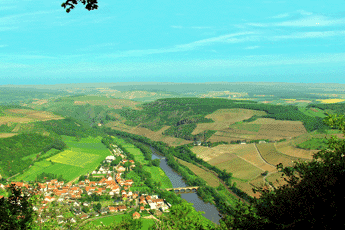 The headwaters of the Nahe river lie in a forest valley, 460 m above sea level, above the village of Selbach in the Saarland district of St. Wendel. The constantly changing landscape with its extensive forests, narrow ravines, and wide floodplains that abruptly open up, follow the river on its 112 km route to the Rhine. On the upper Nahe, in the Idar-Oberstein area, one finds semi-precious stones such as agates, amethysts, mountain crystals and chalcedony, which were commercially mined until the end of the 19th Century. In Kirn, the next largest small town, there is a splendid view from the ruins of Kyrburg. A little downstream from Bad Sobernheim , at the foot of Disibodenberg ,
the largest tributary, the water-rich Glan, flows into the Nahe. In the Glan valley lies Meisenheim , with an old town from the Middle Ages which is worth seeing. From Disibodenberg, the Nahe flows onwards to Bad Münster am Stein and Bad Kreuznach, where saltwater springs are the basis for the health and spa industry. In the past, these saltwater springs also served as sources for salt (salt works and graduation houses). A few kilometers northwest of Bad Kreuznach, in the Ellerbach valley, lies Sponheim with the former monastery church of St. Martin, the most significant romanesque building in the Nahe-Hunsrück region. Near Bingen the Nahe finally reaches the Rhine.
Above is a picture from Lemberg, which is near Bad Münster am Stein in the middle of a 100,000 hectare nature preserve with steep mountain slopes covered by enormous amounts of scree and many rare plants. From the peak of Lemberg one has an unparalleled view of the Nahe Valley below as well as over a wide part of Hunsrück. A picture book worth seeing: Naheland Impressionen; Kreisverwaltung Bad Kreuznach, 1994 The headwaters of the Nahe river lie in a forest valley, 460 m above sea level, above the village of Selbach in the Saarland district of St. Wendel. The constantly changing landscape with its extensive forests, narrow ravines, and wide floodplains that abruptly open up, follow the river on its 112 km route to the Rhine. On the upper Nahe, in the Idar-Oberstein area, one finds semi-precious stones such as agates, amethysts, mountain crystals and chalcedony, which were commercially mined until the end of the 19th Century. In Kirn, the next largest small town, there is a splendid view from the ruins of Kyrburg. A little downstream from Bad Sobernheim , at the foot of Disibodenberg ,
the largest tributary, the water-rich Glan, flows into the Nahe. In the Glan valley lies Meisenheim , with an old town from the Middle Ages which is worth seeing. From Disibodenberg, the Nahe flows onwards to Bad Münster am Stein and Bad Kreuznach, where saltwater springs are the basis for the health and spa industry. In the past, these saltwater springs also served as sources for salt (salt works and graduation houses). A few kilometers northwest of Bad Kreuznach, in the Ellerbach valley, lies Sponheim with the former monastery church of St. Martin, the most significant romanesque building in the Nahe-Hunsrück region. Near Bingen the Nahe finally reaches the Rhine.
Above is a picture from Lemberg, which is near Bad Münster am Stein in the middle of a 100,000 hectare nature preserve with steep mountain slopes covered by enormous amounts of scree and many rare plants. From the peak of Lemberg one has an unparalleled view of the Nahe Valley below as well as over a wide part of Hunsrück. A picture book worth seeing: Naheland Impressionen; Kreisverwaltung Bad Kreuznach, 1994 |
Soonwald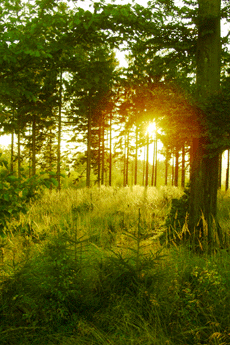
The Soonwald is one of the largest contiguous areas of forest in Germany. Its altitude (400-600 m; the highest peak is Ellerspring at 657 m), its low population density, and its distance from the large transportation routes of our time make it an ideal recreation area for people seeking peace and quiet. This wooded area is well developed. It has over 800 km of circular hiking paths with observation towers at the most beautiful spots, which afford spectacular panoramas. You can hike here for hours without ever meeting another human being, although traces of more than two thousand years of human history can be found everywhere. There are, on the heights of mountain ridges, ancient Celtic hilltop forts, surrounded by gigantic stone walls which easily exceed several hundred meters in length; there are ancient Roman long-distance roads, constructed some 2,000 years ago at a standardized width of 5 to 6 meters and protected by watchtowers at regular
intervals; and there are the remains of luxurious Roman villas. In addition, we find medieval fortresses and castles from the glory days of the political might of Sponheim and Kurtrier. And, there are churches and monasteries in the architectural style typical of Hunsrück with ingeniously painted surfaces and galleries; evidence of a very special race of people, who despite difficult living conditions and scant resources created their own works of art over hundreds of years. A race of people who, incidentally, you still encounter today on the farms of the elevated plains or in the village guest houses.
A picture book worth looking at: Uwe Anhäuser, Kultur-Erlebnis Hunsrück; Idar-Oberstein: Dr. Gebhardt & Hilden, 2000
Wanderführer: Wolfgang Bartels, Hunsrück; DuMont Buchverlag, 1996 und Norbert Forsch, Hunsrück; Deutscher Wanderverlag, 2000
Ergänzende Literatur: Landesgeschichtlicher Exkursionsführer Hunsrück; mit Beiträgen von A. Bauer, B. Lipps, W.H. München, E. Schaaf und K.H. Weichert, Herausgeber: Hunsrückverein e.V., Arbogast Verlag Otterbach, 1993 |
Idarwald mountain range with Idarkopf (746 m) 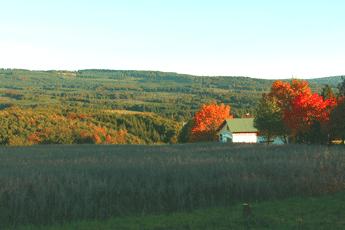
Lonely forests, peaceful creek valleys, and protected moors are the distinguishing features of Idarwald mountain range, a quartzite ridge whose two highest points are An den zwei Steinen (766 m) and Idarkopf (746 m). It is not only the extensive stretches of untouched nature that fascinates visitors and draws them from near and far. The "German Gem Road" from Idar-Oberstein leads through such picturesque places as Herrstein, Schauren, and Allenbach into the heart of the region. Relaxation, enjoyment of nature and the landscape, looking for minerals, and getting enthusiastic about the manufacture and processing of gemstones —all this can be combined here in the most pleasant way. What should also not be overlooked are distinct traces of a very old cultural landscape, whose roots reach far back into prehistoric times, which can be found everywhere. The reconstructed Celtic 'Altburg' fortress near Bundenbach or the 'Belginum' archaeological
park near Morbach allow you to experience this era up close. The only castle surrounded by water in Hunsrück is located near Morbach and reminds us of the Trier Archbishop and Elector Balduin von Luxemburg, one of the greatest protagonists of the Middle Ages in Hunsrück.
A picture book worth looking at: Uwe Anhäuser, Heimat am Idarwald; VG Rhaunen, 2001
Hiking guides: Wolfgang Bartels, Hunsrück; DuMont Buchverlag, 1996 und Norbert Forsch, Hunsrück; Deutscher Wanderverlag, 2000 |
Hochwald with the Erbeskopf (818 m) 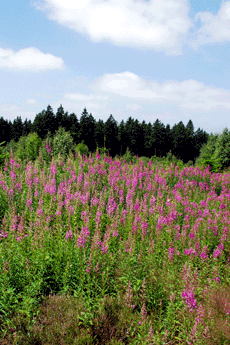
The Hochwald with its dense forests surrounding the 818 meter high Erbeskopf (the highest mountain west of the Rhine in Germany) is a fertile source of sagas and heroic tales. Many researchers of local history suspect that here in this pristine area of the Hunsrück plays one of the central scenes of the medieval Nibelungenlied.
In this place, according to the saga, Hagen von Tronje slew the noble hero Siegfried at the behest of Brunhilde. In fact, Drohnecken castle at the foot of Erbeskopf mountain is thought to be a possible family seat of Hagen von Tronje. Hagen's friend Hunold is thought to come from the nearby Hunolstein castle. Moreover, the towns of Worms and Alzey —the most important locations in the Nibelungenlied— are little more than a day ride on horseback from the Hunsrück mountain range.
A picture book worth looking at: Uwe Anhäuser, Heimat am Idarwald; VG Rhaunen, 2001
Hiking Guides: Wolfgang Bartels, Hunsrück; DuMont Buchverlag, 1996 und Norbert Forsch, Hunsrück; Deutscher Wanderverlag, 2000 |
The Mosel valley from Trier to Koblenz 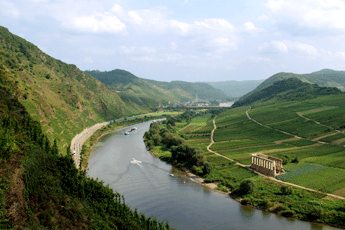
The Mosel river with its length of 545km, isn't even half as long as the Rhine. It has its source in the southern Vosges, from where it winds through the area of Trier in order to reach a branch of the Hunsrück.
From there, until it meets the Rhine at Koblenz, it flows through the deeply cut, winding valleys of the Rhenish slate mountains, creating a natural boundary at the north of the Hunsrück. The Mosel valley is an important wine growing area with famous names such as Bernkastel, Traben-Trarbach, Zell and Cochem.
Guide book: Reinhold Schommers, Mosel; DuMont Buchverlag, 2001 |
The Rhine valley from Bingen to Koblenz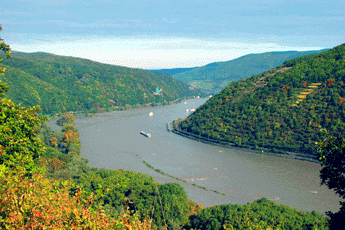
The Rhine has covered two thirds of its 1320 km long trip from the Swiss Alps (canton Graubünden) to the North Sea by the time it meets a branch of the Hunsrück near Bingen. Starting here, it flows through the slate mountains of the middle Rhine region. The traveler passes through a very narrow 300m deep ravine where the Hunsrück is a natural boundary. Then he traverses the fascinating landscape of Hunsrück on his way downstream.
Along this way he sees world famous places such as Bacharach, Kaub, or St. Goar with the overwhelming rock of Loreley. He sees Boppard with its impressive Rhine loop and picturesque Rhens. At Koblenz, at the mouth of the Mosel in the Rhine, he has reached the most northerly point of the branch of the Hunsrück. It isn't far from here and the Rhine widens, with all the narrows left behind. The low plains now determine the flow of the Rhine to the North Sea.
Hiking guide: Wolfgang Bartels, Hunsrück; DuMont Buchverlag, 1996 und Norbert Forsch, Hunsrück; Deutscher Wanderverlag, 2000 |
District of Rhine-Hunsrück (Simmern): Culture and Economy
The Middle-Rhine, a World Heritage Site
The 65 km long upper part of the middle-Rhine valley between Bingen and Koblenz, is, in its uniqueness, of special importance. For this reason, it was entered in the World Heritage list of UNESCO on 27 June 2002. It is an excellent example, worldwide, of a cultural landscape, which in times past sometimes acted as a barrier between cultures, but also one that connected diverse cultures to each another. This is a cultural landscape that is closely linked to the development of the West; a place where one encounters significant evidence of art, urban development, and history, as well as a close interaction between man and nature at every turn. A cultural landscape whose lively history reflects the spiritual, artistic, and literary life of Europe as no other European cultural landscape can. For this reason, UNESCO's decision was accepted by the people with much enthusiasm and celebrated with a grand folk festival along the Rhine.
Frankfurt-Hahn Airport
The only international airport in Rhineland-Pfalz is in the Rhine-Hunsrück area. Hahn airport is officially called Frankfurt-Hahn Airport due to its close connection to the large airport at Frankfurt. It was originally a US Airforce base, which was closed in 1993. The results of the largest conversion project ever undertaken in the country are evident: the freight department of the airport is now the fourth largest in the country, and the number of passengers is climbing steadily. In 2002, there were already about 1.5 million passengers. Due to Ryanair's decision to open a branch at Hahn airport, the Irish airline with its new destinations is expected to increase this number to several million passengers per year. The airport functions as the engine for business and the job market of the region. It has generated more than 2,200 new jobs so far.
Middle-Sized Businesses
The economic backbone of the region on the Rhine and Hunsrück heights consists of several thousands of solid, middle-sized businesses, while large businesses, to a great extent, fail. One important economic sector is handwork. Over 1,100 handwork business offer work to almost 8,000 employees in the Rhine-Hunsrück district. Affordable land prices in increasingly convenient locations (good connections to the A61 autobahn, as well as to the planned federal highways B50 and B327) offer an attractive environment for various kinds of businesses. In addition, a large number of motivated, ambitious, and highly qualified workers can be found in this region. Another important point are the prospects that that the Frankfurt- Hahn airport offers to business and tourism in Hunsrück.
Decrease of Agriculture
The structure of agriculture in the Rhine-Hunsrück district have changed a lot over the last three decades. The decrease in the number of farms is especially noticeable: in 1971 there were 5,039 farms, while in 2001 there were only 1,322 farms where the farmers either worked part- or full-time. At the same time, farming took on a new "form". The percentage of full-time farmers fell from 42.1% to 18.9%. The amount of land used for farming reduced only slightly, meaning that farms today are much larger than just a few decades ago. While in the past almost every family in a village farmed, today there are villages with no farmers living there. The decline in farming is also reflected in the keeping of animals. Between 1970 and 2001, the number of cattle fell from 58,000 to 21,000, this is a reduction of almost one-third. Farms with just a few heads of cattle are rare today. In wine growing, as well, the structural changes have not gone unnoticed.
In 1971, in the central Rhine valley of the Rhine-Hunsrück district, there were 256 hectares of land planted with grapes, while in 2002 there were only 148 hectares. |
|
|
 |
|
|
 |
 |
 |
|
|
Hotel Maasberg Therme • 55566 Bad Sobernheim • Tel: + 49 (0 67 51) 87 60 • Fax: + 49 (0 67 51) 87 62 01 • E-mail: info@maasberg-therme.de |

